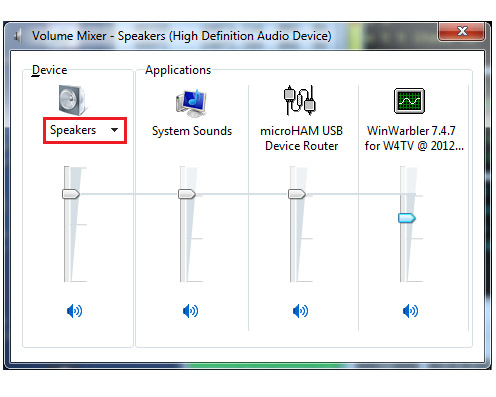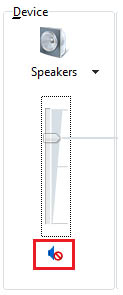Setting the AFSK Audio Output Level for RTTY and Phone Operation on Vista, Windows 7, Windows 8, Windows 10, and Windows 11
de Joe, W4TV
This adjustment is only required if you are transmitting RTTY via AFSK or transmitting Phone audio.
- set your transceiver's RF output power level to 100%, and disable compression
On WinWarbler's Main window, set the Operating Mode panel to RTTY
On the Configuration window's Soundcard tab, click the Mixer adjustments panel's Transmission button to display Windows' Volume Mixer window:
If the Volume Mixer window does not appear, click the Speaker icon in Windows' notification area (lower-right corner of the screen), and at the bottom of the window that appears, click Mixer to display the Volume Mixer window
If your output device is not selected in the Volume Mixer window's Device panel,
On Windows Vista, use the Volume Mixer window's Device menu to choose the correct output device
On Windows 7, use the Device selector (highlighted by the red box in above picture) to choose the correct output device
If the speaker icon beneath the Device panel's vertical slider displays a slashed red circle, the output device is muted; click the speaker icon to unmute it:
set the Device panel's slider to 75% (this panel's slider serves as a master volume control)
- monitor your transmitter's output power level
- connect your transceiver to a dummy load, or QSY your transceiver to a clear frequency
- For transceivers including most older Yaesu, Icom (except the ic-7800) and most Kenwood rigs (except the TS-870) that have a single mic gain control,
- set the microphone gain to its normal position for phone operation
on WinWarbler's Main window, click the Transmit panel's Start button
increase the Applications panel's WinWarbler slider until the transceiver's RF output reaches the desired value, which should occur with very little ALC
if the Applications panel's WinWarbler slider must be set higher than 80% or lower than 50%, adjust the Device panel's slider up or down so that the Applications panel's WinWarbler slider can remain between 50% and 80%
if both Applications panel's WinWarbler slider and Device panel's slider must be set below 50%, use an attenuator between the soundcard's line out and the transceiver input (the Soundcard to Transceiver connection).
For transceivers like the Elecraft K3, TenTec Orion, Icom 7800, Kenwood TS-870 and newer Yaesu rigs that have a separate level control for their backpanel transceiver audio input (typically a menu item or an internal trimmer)
set the Applications panel's WinWarbler slider slider to 80%
- set the transceiver's backpanel transceiver audio input level control to minimum
- connect your transceiver to a dummy load, or QSY your transceiver to a clear frequency
on WinWarbler's Main window, click the Transmit panel's Start button
- increase the the transceiver's backpanel transceiver audio input level control until the transceiver's RF output reaches the desired value
if both Applications panel's WinWarbler slider and Device panel's slider must be set below 50%, use an attenuator between the soundcard's line out and the transceiver input (the Soundcard to Transceiver connection).
- For transceivers including most older Yaesu, Icom (except the ic-7800) and most Kenwood rigs (except the TS-870) that have a single mic gain control,
Notes:
If you're using Windows 10 or Windows 11, enable Let apps use my microphone in the Settings window's Microphone section. If this option is disabled, applications will be prevented from using any audio device.
The Elecraft K3's ALC indicator is really an audio drive meter; AFSK drive levels should be 5 bars. If the audio drive is set too low, the ALC will attempt to compensate and power control will be inconsistent.
Setting the Audio Input Level for RTTY Operation


